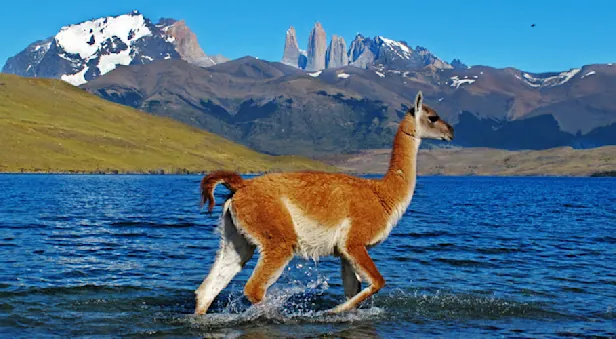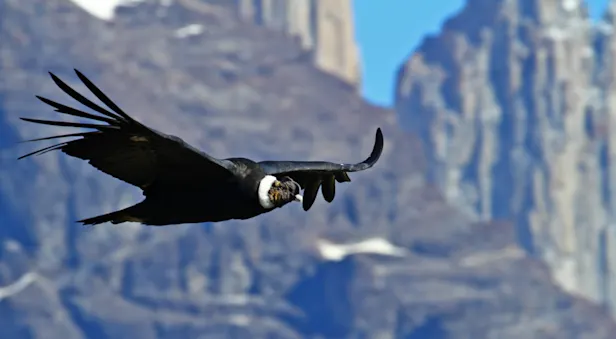Andean Condor Facts | Patagonia Wildlife Guide
PHYSICAL CHARACTERISTICS
Male Andean condors are one of the largest flying birds on the planet. Andean condors are the largest vultures in South America, weighing between 18 and 33 pounds. They have a body length that’s 40 to 52 inches and an enormous wingspan of 8.1 to 10.6 feet. The Andean condor’s scientific name is Vultur gryphus—vultur meaning to tear, in reference to its consumption of flesh, and gryphus, referring to the mythological griffin.
Andean condors have black plumage bedecked with white flight feathers. Their naked, fleshy heads are an ideal adaption for feasting on carrion: the absence of feathers allows them to poke their heads into animal carcasses without becoming overly soiled. Loose folds of reddish-black skin hang on the head and neck. Andean condors are sexually dimorphic; males have a scarlet comb, called a caruncle, over their beak.
HOME RANGE
The range of the Andean condor was once widespread, stretching from Venezuela to the Tierra del Fuego at the tip of South America. Though still found in most regions of the Andes, their population in each area has been dramatically reduced, with the largest known population remaining in northwest Patagonia.
Andean condors are primarily found soaring over open grasslands and mountainous alpine regions, descending to lower elevations to forage in the southern beech forests of Patagonia and the lowland deserts of Peru and Chile.
FEEDING HABITS
The Andean condor uses its sharp sight and intellect to seek out prey. They comb the mountainside, searching for their preferred meal—carrion—above the open páramos of the Northern Andes. Similar to other predators, the feeding order of Andean condors is determined by a social hierarchy, with the oldest male feeding first and the youngest female last. These vultures cover vast distances of up to 200 miles each day, and the great heights at which they fly make it extremely difficult to visually track their numbers or migratory patterns.
Able to glimpse a carcass from miles away, these birds scavenge the remains of most mammals, including alpaca, guanaco, cattle, rhea and deer. They sometimes steal eggs from the nests of smaller birds and take the newborns of other animals. Quite often, Andean condors will trail smaller scavenger birds to find a carcass. This relationship is beneficial to both parties, as the condor tears open the tough hide of carrion, providing easier access to slighter scavengers. During fights with other birds over carrion, the condor relies on ritual displays to convey dominance. Conflicts resolve quickly once the exhibition demonstrates the more dominant bird. Physical altercations are rare due to the condor’s delicate feathers.
BEHAVIOR
Andean condors ascend to heights of 18,000 feet. They rely on thermal air currents to traverse their vast home range. Condors lower their body temperature during the night to conserve energy and raise their wings repeatedly during the day to warm back up. As they spread their wings, they straighten the feathers that may have bent from continual flight. Condors are generally silent creatures, lacking a voice box but are able to make some sounds such as grunts and wheezes.
REPRODUCTION
Andean condors mate for life and can live up to 50 years in the wild. Although the condor has a long lifespan, it breeds very slowly, as it does not mature until it reaches between 6 and 8 years of age. These birds most often roost in boulder crevices and on ledges of cliffs in mountainous terrain. Nests consist merely of a few scattered twigs, as trees and plant material are scarce at such high elevations. As nests are inaccessible to most predators and are fiercely guarded by both parents, predation of eggs and hatchlings is uncommon, though foxes and birds of prey occasionally come close enough to take one.
The female lays a single bluish-white egg that is incubated by both parents for about 59 days. As the young take much time and effort to raise, condors only have one chick every other year. Young cannot fly until they reach 6 months, and they continue to rely on their parents for two more years.
CONSERVATION STATUS
The Andean condor population has been severely compromised over the last several years, although they still are not officially listed as an endangered species. Today, condors are hunted for sport, and they are often killed by farmers trying to protect their animals. In addition, condors risk death from pesticides, which accumulate in their prey, especially affecting predators at the top of the food chain. Reintroduction programs of captive-bred condors and conservation education efforts have aided in the preservation of this treasured bird, the national emblem of so many South American countries.
Header Credit: Cassiano Zaparoli
See Andean Condors on These Patagonia Adventures

Wild Patagonia: Peaks, Glaciers & Pumas
An all-encompassing expedition straddling Chile and Argentina! Marvel at the granite spires of Torres del Paine, survey the vast ice face of Perito Moreno Glacier, search for pumas and see condors soar.



































